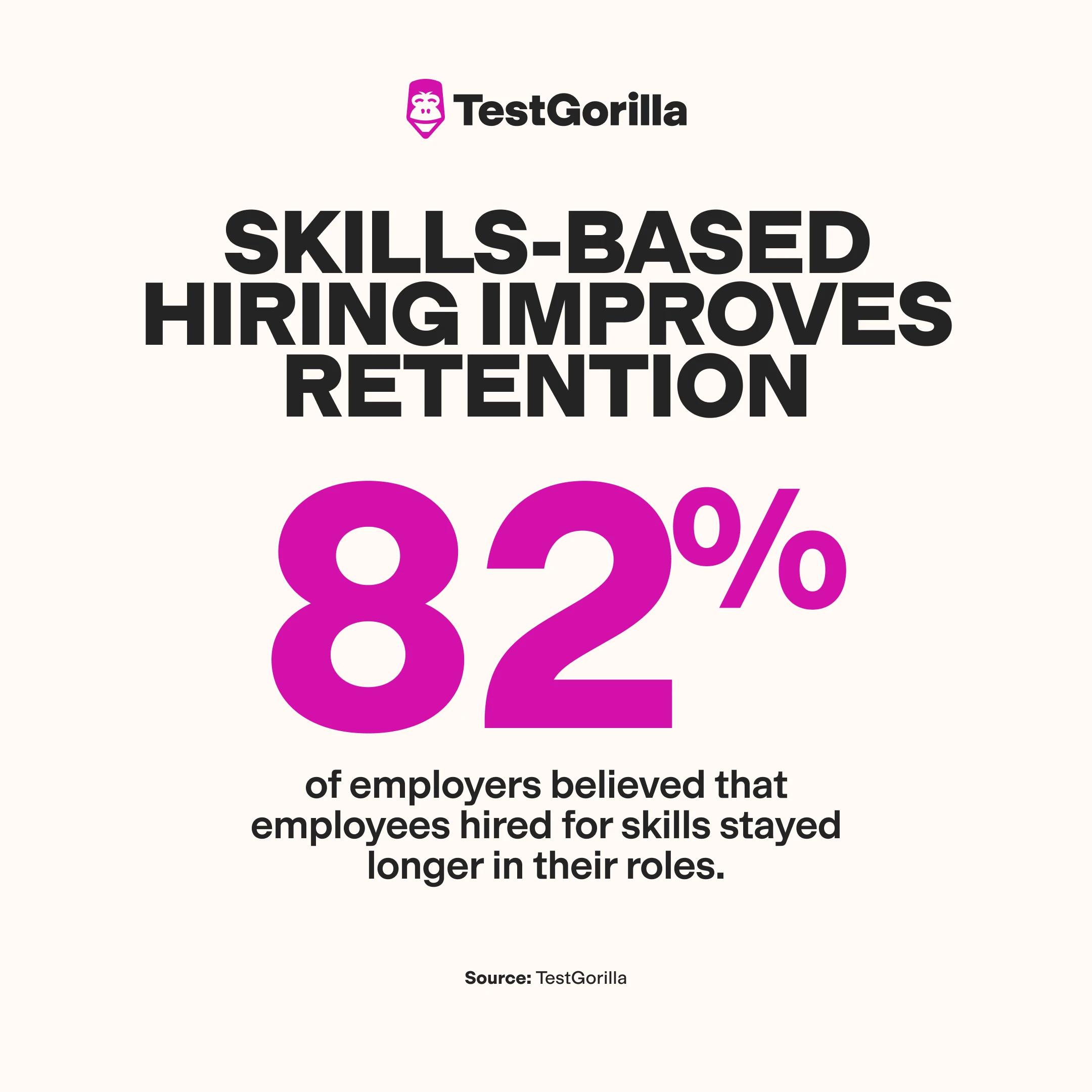Losing talent can seriously disrupt growth and put your business on the back foot. If that’s not scary enough – replacing employees in today’s deprived labor markets is tough.
It’s no surprise that retention is currently top of mind for most employers. [1] Despite this, the last few years have seen some of the worst turnover rates in decades [2], leaving employers confused and frustrated.
So, what’s going wrong?
Maybe you’re hiring people who were a flight risk to begin with. Perhaps you’re trying to fix problems when it’s already too late. Or maybe you’re using outdated retention strategies that don’t work anymore.
Whatever the reason, we can help. You can avoid so much of the above with a single change to your hiring strategy. In this guide, we show you how skills-based hiring is the ultimate way to find – and keep – the best talent.
Table of contents
The costs of losing talent today
Here’s why you simply can’t afford to lose talent in today’s landscape.
Stalls progress
In conversation with us, HR expert Yashna Wahal shared interesting insights about why turnover damages businesses more now than before.
“Gone are the days when four employees were hired to do the same job. Today, we run lean teams where each employee has a specific and unique contribution toward team goals. While this is excellent for efficiency, it puts you at risk of total disruption when someone leaves.
When you lose experienced team members, there’s usually a gap before you find a replacement and get them up to speed. This gap can slow operations, affect service quality, and delay project deadlines.
This is bad for business – and gives competitors the perfect opportunity to swoop in and capture your market share.
Makes you vulnerable
Post-pandemic, the labor market was tight, with more jobs than skilled workers to fill them.
Reuters recently found that with the number of open jobs falling, labor market conditions are gradually easing. But, the Federal Reserve noted that “difficulties [have] persisted [in] attracting workers for highly skilled positions.”
With labor markets in a constant limbo, losing talent reduces workforce stability and makes you more vulnerable to market moods.
Significantly increases expenses
Losing valuable employees can set you back financially, too. The Society for Human Resource Management (SHRM) found that, on average, companies pay $4,700 to hire a new employee, and the cost can go up to three to four times the position’s salary.
When replacing an employee, you’ll likely pay 18-20% more in salary to hire externally. Plus, you’ll have to bear additional expenses, like recruiting agency or platform fees, candidate travel expenses, and costs associated with leaders’ time spent in the hiring process.
Destroys your employer brand
Companies with high turnover rates raise all sorts of questions in the job market, like “Why are so many people leaving?” These companies eventually earn labels as bad employers on websites like Glassdoor, where today’s tech-savvy workers openly share their views and feedback.
The irony is that a bad reputation leads to more departures since your employees might consider moving to better firms. Talk about a vicious cycle!
Creates a negative work environment
When an employee leaves, it’s not uncommon for your existing team members to pick up the slack and take on additional tasks until you’ve found a replacement. And in most cases, you’ll also depend on these team members to show new hires the ropes.
When your existing team is already at capacity, asking them to do more can lead to frustration, resentment, and burnout. This can create a toxic ambience and even push more team members out the door.
The real reason for employee departures
Studies from Pew and Forbes looked into why employees quit their jobs. Not surprisingly, employees cited reasons such as lack of flexibility, problems with colleagues or customers, high workload, and so on.
The usual narrative puts the blame entirely on employers for not providing employees with what they need.
While this can be true, it’s not always the case.
Our view? The real problem is that employers are mis-hiring employees without properly checking if they align with the role, team, or company.
For example, not all employers are expected to provide flexibility. But if they hire someone who’s looking for flexible hours, the employee is doomed to be disappointed and jump ship.
So, what’s happening here?
HR expert Yashna Wahal shared her thoughts on this.
“Companies invest time, effort, and money in following the rules. But traditional, by-the-book hiring methods just don’t work – and if I’m honest, they never did. If they were effective, you wouldn’t see so much attrition in the first place.”
How traditional recruiting silently kills retention rates
Let’s explore how traditional hiring hurts long-term employee retention.
Degree-based selection
A Harvard Business Review article showed a weak correlation between college degrees and job performance. Despite this, employers hire people with fancy degrees or from top-notch colleges – assuming that these candidates are more likely to succeed.
If you don’t assess candidates’ real-world skills, you’re more likely to hire someone who can’t perform, doesn’t like their job, and eventually walks away – assuming you don’t let them go first.
What’s more – when you’re obsessed with degrees, you’ll also lose out on top talent skilled through alternative routes (STARs) who may have been better suited for the job and stuck with you for a longer time.
Resume screening
We recently interviewed 1,500 employers, and 87% said they experienced problems with resumes. Fifty-one percent weren’t sure about resume accuracy, and 43% found it difficult to determine candidates’ skills from their resumes.
Relying on resumes to screen applicants can lead to progressing candidates who look good on paper but struggle with the job. Additionally, resumes tell you nothing about candidates’ personalities, attitudes, and motivations.
While you can check for these in interviews, you might have already rejected someone who could have been a perfect long-term match just because they didn’t have an impressive-looking resume.
Unstructured interviews
Did you know that 92% of employers use unstructured interviews in their selection process? In these interviews, interviewers make up questions as they go rather than using a fixed set of questions for every candidate. The idea is to delve into applicants’ backgrounds, attitudes, and personalities in an informal way.
The downside, however, is that it’s easy to go off on a tangent. You could skip asking candidates crucial questions relating to their skills, knowledge, and decision-making. In these instances, you might select someone based on your gut rather than reliable data, increasing the likelihood of hiring a candidate who won’t stay the course.
One-way evaluations
Finally, traditional recruiting can often be an entirely one-sided process where companies evaluate candidates. Applicants who don’t have opportunities to learn more about a job or the company’s culture might feel misled or dissatisfied when they start work.
In fact, one survey found that a third of new employees quit their jobs within the first six months. Forty-three percent said they’d quit because their new job didn’t meet their expectations.
Why is skills-based hiring the ultimate way to retain talent?
Properly assessing job fit at the time of hiring could have prevented the problems we just discussed.
And what’s the best way to do this? Skills-based hiring.
Skills-based hiring focuses on candidates’ skills and abilities for a job rather than relying on their educational qualifications, previous job titles, or companies they’ve worked for.
Companies using a skills-based approach use online tests, technical and behavioral interviews, case studies, simulations, and other practical tools to make screening and offer decisions.
Reasons skills-based hiring helps with retention
Deloitte surveyed 225 business and HR executives from around the world. Results showed that skills-based companies were twice as likely to retain top performers than others.
Our research also showed that 89% of employers improved retention using skills-based hiring. Additionally, 82% of employers believed that employees hired for skills stayed longer in their roles.
Here’s how skills-based hiring helps with employee retention.
1. Prevents mis-hiring
When employees are selected based on the skills needed for a job, there’s a good chance they’ll perform well in their role. In fact, 89% of employers agree that skills-based hiring predicts job success. This sense of competence and fulfillment can increase job satisfaction, which is closely linked to employee retention.
Beyond technical expertise, skills-based hiring also lets you measure the personality traits associated with success in a specific role or work environment.
For example, if you encourage a “fail fast” culture where employees must experiment with strategies and adapt quickly, you might want to look for candidates who are creative, resilient, and comfortable with failure. Someone who doesn’t have these qualities could find the job too fast-paced or stressful and move onto something that better suits them.
Lindie van der Westhuizen, Senior Manager of Measurement Science & Research at TestGorilla, put this nicely:
“Skills-based hiring can lead to higher job satisfaction and retention by ensuring employees are well-suited and engaged in their roles from the outset.”
2. Enables two-way evaluations and candidate self-selection
In addition to letting you assess candidates, skills-based hiring gives applicants a glimpse of what’s expected of them in a new role – so there aren’t surprises when they join.
For instance, putting candidates through tests, case study exercises, or simulations helps them learn more about the skills they need for the job, at least to some degree. Candidates who don’t find the work enjoyable or stimulating can choose to opt out of the process at this stage – rather than once they’ve joined the company.
Nikky Knijf, one of our Product Managers, said this about skills-based hiring:
“When candidates apply for these roles that use skills-based hiring, they're better informed – they have an idea in their [head] of ‘okay, if I apply for this job, this is what they're looking for.”
3. Promotes career development and internal mobility
Recent research by SHRM showed that 68% of workers said they’d stay with their employer throughout their career if the company helped them upskill. Similarly, 65% said they’d stay loyal if their employer helped them re-skill.
Modern employees want opportunities to switch careers and expand their horizons, and this is where skills-based methods come in.
In our own research, over 50% of respondents said they’d switched to an entirely different department or field over the last year. Of those who changed careers, 38% were able to change careers by taking skills-based tests and 53% by answering skills-based interview questions.
Assessing employees’ skills and abilities can give you a better sense of which other roles they’re skilled for or have the aptitude to learn effectively. In doing this, you can provide them with internal growth and mobility opportunities so they don’t need to go elsewhere for a fulfilling career.
But skills-based hiring doesn’t just help career switchers. It also opens up opportunities for those who stick to the same career path – including current employees seeking upward progression at their companies.
Here’s what Mehdi Khachani, Owner of JMK Plumbing, had to say about this.
“Skills-based hiring [empowers] employees to explore diverse career paths within our organization based on their skill sets and aspirations. By fostering a culture of internal mobility and upward progression, I not only retain top talent but also cultivate a loyal and motivated workforce committed to our shared success.”
In our study, 86% of employees felt that having the right opportunities to showcase their skills could land them their ultimate dream job – one they’d want to stay and progress in long-term.
4. Boosts employee confidence and motivation
Ultimately, whether you’re hiring someone new or moving an existing worker to another role, putting employees in jobs they’re truly skilled for will likely increase their confidence, satisfaction, and retention levels.
In fact, in our research we found that employee happiness levels were 10% higher for skills-based hires compared to experience-based hires
Operations manager Jessica Rubin shared a first-hand experience of how skills-based hiring helped improve retention at Harbor Yachts.
“By prioritizing skills and how they align with our operational needs, we've fostered a work environment where team members are placed in roles that play to their strengths, thus boosting morale and retention. They're more engaged, feel valued, and are motivated to contribute to our collective success.”
5. Fosters a diverse and inclusive environment
A recent piece in People Management reveals that attractive wages and benefits are no longer guarantees of securing and retaining talent. They explain that for today’s employees, especially the new generation of workers, a diverse workplace significantly improves staff retention.
Harvard Business Review takes this a step further, highlighting the importance of not just diversity but also inclusion. They point out that no amount of free coffee, generous bonuses, or recognition programs will work if employees aren’t comfortable to be themselves at work.
Skills-based hiring removes unconscious biases through objective, data-driven decisions. Ignoring credentials, backgrounds, or demographic factors that have nothing to do with performance makes hiring fair and inclusive.
Plus, you’re more likely to build a diverse workforce and merit-based company that employees are proud to work for.
In our study, 84% of employers found that skills-based hiring improved diversity. Additionally, Deloitte showed that skills-based organizations were 47% more likely to provide an inclusive environment.
How to retain talent using skills-based hiring methods
Here’s how you can adopt skills-based hiring to improve employee retention in your company.
1. Widen your candidate pool
Skills-based hiring means giving everyone a fair chance to demonstrate their capabilities for a role.
So, source candidates from beyond traditional channels like campus hiring. For instance, join networking events or host hackathons to meet and connect with candidates from all walks of life.
Additionally, write skills-based job descriptions. That means focusing on the knowledge and skills needed for the specific role rather than asking candidates for degrees or certain experience. This way, you’ll tap into a wider talent pool, make stronger hiring decisions, and recruit candidates who might be better long-term fits.
2. Swap resumes and profile-based hiring for multi-measure talent assessments
Viewing candidates’ resumes and LinkedIn profiles leads to biases that weaken hiring decisions. For an authentic skills-based approach, ditch these inaccurate tools and opt for talent assessments instead.
Talent assessments are online tests that measure candidates’ job-specific skills, aptitudes, personality traits, and more. They’re fair, objective, and incredibly easy to roll out with a platform like ours.
TestGorilla offers hundreds of tests to choose from. You can combine up to five tests in a single multi-measure assessment and even add custom questions for deeper insights.
With our tests, you can evaluate internal and external candidates on hard skills, cognitive abilities, soft skills, and situational judgment. This gives you a holistic view of a candidate’s suitability for a role.
Additionally, don’t forget to put candidates through personality assessments, which are critical to better retention. TestGorilla offers these, too.
In fact, Lucija Primorac, a Customer Success Advisor at TestGorilla, said –
“Customers are using TestGorilla to solve the pain point of having higher attrition, meaning they want to test for skills such as resilience, motivation, stress tolerance, etc.”
Finally, at TestGorilla, we believe a candidate’s ability to fit in with and enhance your company culture will determine whether you retain them.
Put candidates through our culture add assessment to learn about their beliefs, values, and expectations – so you don’t end up with someone who may be technically sound but doesn’t vibe with the team or company.
3. Use structured interviews
Structured interviews, which include a fixed set of carefully crafted, competency-focused questions, offer good insights into candidates’ skills and readiness for a job. Every candidate gets the same questions, making the process fair and less prone to bias.
One study found that, compared to unstructured formats, structured interviews were better at predicting long-term job success, making it more likely that you’ll hire someone who’ll work out in the long run.
Finally, structured interviews also provide a great opportunity to provide candidates with the chance to evaluate your company. So, describe your company’s culture and ask candidates questions about their ideal workplace and culture to see if there’s a match.
Cut the tension in retention with skills-based hiring
Retaining employees is the best way to stay competitive and avoid getting caught in today’s war for talent. But despite following various retention trends, employers are losing workers at lightning speed. Our view? This boils down to bad hiring.
When you base hiring decisions solely on credentials or resumes, you’re more likely to hire employees who are unfit for the job, dislike your culture, or can’t gel with your team – all solid signs of future attrition.
On the other hand, a skills-based hiring approach is the ultimate way to retain talent. With TestGorilla’s skills and personality assessments, for instance, you can hire employees who’ll succeed in their jobs, vibe with your team, and stay for the marathon – not just the sprint.
Sources:
Paige McGlauflin and Joseph Abrams, “Retaining talent has become a top operational priority, beating out revenue growth,” Fortune (2023) https://fortune.com/2023/08/08/employee-talent-retention-becomes-operational-priority/
Vipula Gandhi and Jennifer Robison, “The ‘Great Resignation’ Is Really the ‘Great Discontent’,” Gallup (2021) https://www.gallup.com/workplace/351545/great-resignation-really-great-discontent.aspx
Related posts
Hire the best candidates with TestGorilla
Create pre-employment assessments in minutes to screen candidates, save time, and hire the best talent.
Latest posts
The best advice in pre-employment testing, in your inbox.
No spam. Unsubscribe at any time.

Hire the best. No bias. No stress.
Our screening tests identify the best candidates and make your hiring decisions faster, easier, and bias-free.
Free resources
This checklist covers key features you should look for when choosing a skills testing platform
This resource will help you develop an onboarding checklist for new hires.
How to assess your candidates' attention to detail.
Learn how to get human resources certified through HRCI or SHRM.
Learn how you can improve the level of talent at your company.
Learn how CapitalT reduced hiring bias with online skills assessments.
Learn how to make the resume process more efficient and more effective.
Improve your hiring strategy with these 7 critical recruitment metrics.
Learn how Sukhi decreased time spent reviewing resumes by 83%!
Hire more efficiently with these hacks that 99% of recruiters aren't using.
Make a business case for diversity and inclusion initiatives with this data.



















